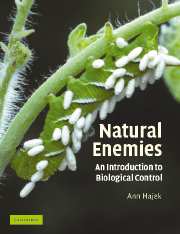Book contents
- Frontmatter
- Contents
- Preface
- Acknowledgments
- Introduction
- PART I Strategies for using natural enemies
- PART II Biological control of invertebrate and vertebrate pests
- PART III Biological control of weeds
- Chapter 13 Biology and ecology of agents used for biological control of weeds
- Chapter 14 Phytophagous invertebrates and vertebrates
- Chapter 15 Plant pathogens for controlling weeds
- PART IV Biological control of plant pathogens and plant parasitic nematodes
- PART V Biological control: concerns, changes, and challenges
- Glossary
- References
- Index
Chapter 13 - Biology and ecology of agents used for biological control of weeds
Published online by Cambridge University Press: 05 June 2012
- Frontmatter
- Contents
- Preface
- Acknowledgments
- Introduction
- PART I Strategies for using natural enemies
- PART II Biological control of invertebrate and vertebrate pests
- PART III Biological control of weeds
- Chapter 13 Biology and ecology of agents used for biological control of weeds
- Chapter 14 Phytophagous invertebrates and vertebrates
- Chapter 15 Plant pathogens for controlling weeds
- PART IV Biological control of plant pathogens and plant parasitic nematodes
- PART V Biological control: concerns, changes, and challenges
- Glossary
- References
- Index
Summary
Types of agents
Plants are used by a great diversity of organisms that have different ways of exploiting them for food and shelter. The majority of herbivores that have been used for biological control of weeds are plant-feeding (phytophagous or herbivorous) invertebrates. These are often classified into guilds according to the plant resources they consume, such as roots, stems, leaves, flowers, seeds, fruits. Secondarily, they can be considered by their style of feeding, such as sucking, chewing, leaf mining, stem mining, root boring. One specialized type of feeding is gall formation. Plant tissues can be attacked by invertebrates early in development and the plant is tricked into creating a specialized enlarged structure called a gall, which often becomes home plus food for invertebrates living within. Affected plants can expend lots of energy making galls, at the expense of other vegetative growth. If a gall is in the reproductive tissues, this leads to reduced seed output.
Where and when an invertebrate attacks a plant can have profoundly different effects and of course this also varies by plant species. Insects attacking the growing tips of plants can have a greater effect than insects solely feeding on leaves, although some plants can compensate for this damage and create new growing tips. Sap-sucking or gall-forming insects often are thought to have little effect, although they cause a prolonged drain on plant nutrients (but see section 14.3.1). Of course, fruit and flower feeders only affect plant reproduction and not the plants that are present.
- Type
- Chapter
- Information
- Natural EnemiesAn Introduction to Biological Control, pp. 217 - 232Publisher: Cambridge University PressPrint publication year: 2004



